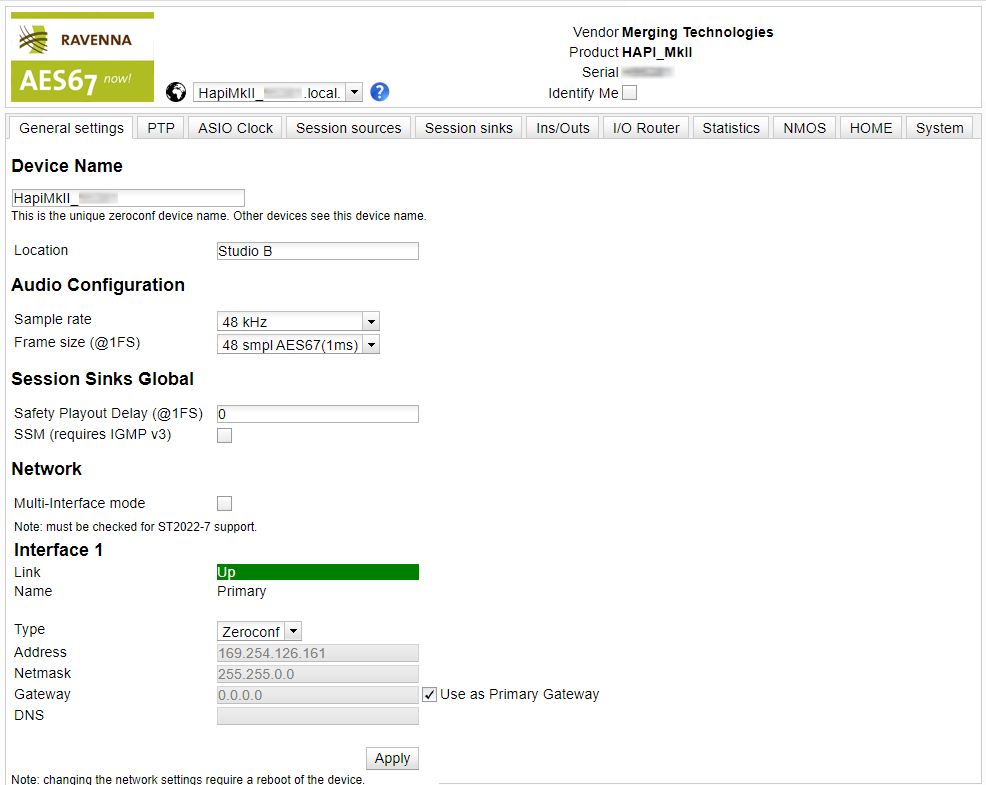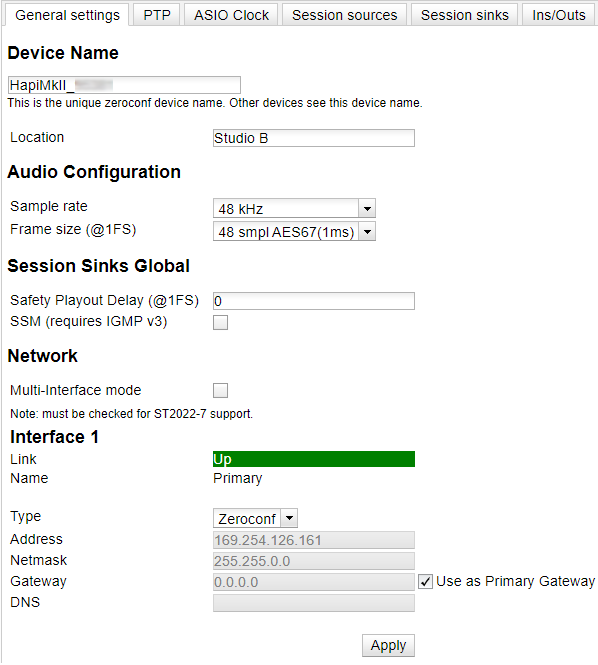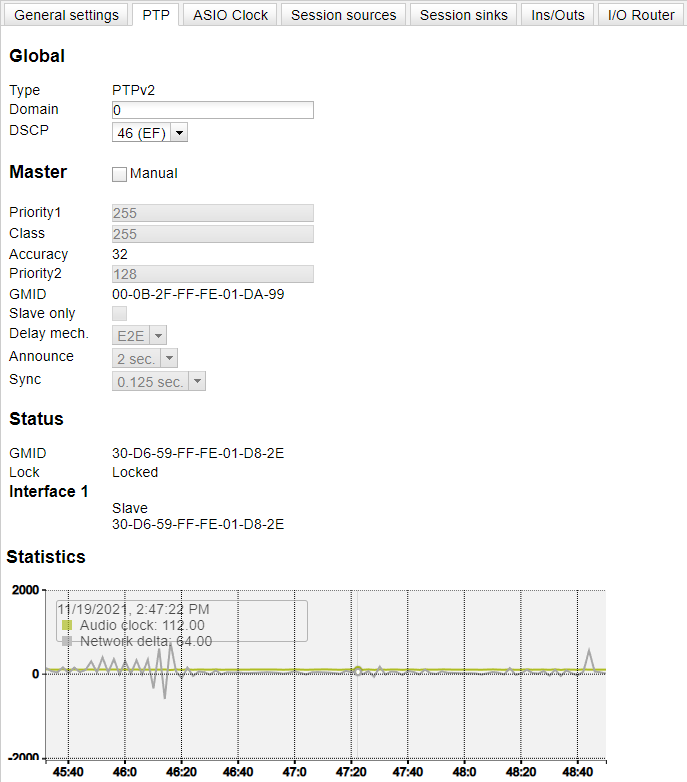


SSM (requires IGMP v3) : Source-Specific Multicast.
If you activate this option, make sure your network switch supports and is configured for IGMP V3.
Note : depending on the device and firmware, only Interface 1 might be available.

PTP Domain : allow to define a specific PTP domain, usually when several PTP masters are required in the same network (default value for Merging devices and programs is 0).
MassCore : Pyramix v11.1.5 / Ovation v7.1.5 |
To modify the PTP setting, you must first tick the "Manual" checkbox.
Slave only : forces the Merging device to always be PTP slave.
Announce : PTP Profile related - PTP announcement interval (0.125 - 0.25 - 0.5 - 1 - 2 - 4 - 8 -16 seconds)
Sync : PTP Profile related (0.0625 - 0.125 - 0.25 - 0.5 seconds)
Statistics (since firmware 3.9.3)
The graph is only active for slave devices. Not available for ASIO device.
Green curve : shows the regulated device delta against the current Master PTP clock.
Grey curve : shows the network delta against the current Master PTP clock, before the device regulation algorithm.
| PTP Priority value : 1 is the highest priority, 255 the lowest one. Merging devices are by default using Priority 127 when set as PTP Master and 255 when PTP slave |


Auto-unicast - retrieve unicast address+port from sink (RTSP) : automatically retrieve the sink (listener) IP address for unicast connection.
This feature only applies to Merging Technologies devices. See this page for further details
Horus - Hapi : firmware v3.9.2 |

Session Status :
![]() : The Sink has been created, and waiting for the Source information to connect.
: The Sink has been created, and waiting for the Source information to connect.![]() : The Sink is trying to connect to the Source.
: The Sink is trying to connect to the Source.![]() : The Sink is connected to the Source.
: The Sink is connected to the Source.![]() : The Sink can't connect to the source, see the error message for details.
: The Sink can't connect to the source, see the error message for details.
Global RTP Status :
In 2022.7 Mode, the Global RTP Status displays the status for both interfaces.
In non 2022.7 Mode, the Global RTP Status will be the same as the interface status.![]() : Waiting for connection
: Waiting for connection![]() : Currently receiving
: Currently receiving![]() : Stream is muted, see Interface RTP Status for further details.
: Stream is muted, see Interface RTP Status for further details.![]() : 2022.7 Mode only - one of the interface is not receiving RTP packets properly.
: 2022.7 Mode only - one of the interface is not receiving RTP packets properly.
Session name : defined in SDP (usually the same as the source name)
Playout Delay : current playout delay on the selected sink in samples (and ms).
RTSP Host : connected source IP
Allows to change the name of module's specific Inputs and / or Outputs. (when applicable)
Depending of the sampling rate, some modules may not be available.
Note : The module has to bet set to RAVENNA mode (Module page Output Source : Ravenna), otherwise it will not be displayed in that page.
ZMAN-based devices only.
Allows to connect physical I/O and Internal device router.

Virtual Audio Device (VAD) only (since V3.2.0.50895)
Allows to declare devices with static IP addresses and ports (JSON format). This feature has been designed for setups where Bonjour cannot be used (e.g. usage of routers).
The declared devices will afterwards appear in the VAD Panel (with their respective icons if online, otherwise with a generic icon if offline)
eg. [{"IP":"192.168.1.99", "port":80},{"IP":"192.168.1.124", "port":80}]ZMAN-based devices only - Under Construction


Note : NMOS Node API (IS-04) V1.2 and NMOS connection API (IS-05) V1.0 are currently supported.
Please also see the NMOS Implementation Notes
This section provides status information about the Registration Server.

HOME
Home Server: NATS server address (alternatively, the Home Server IP address and port can also be entered).
Note : Home must be disabled to access the settings.
Enable: enable or disable the Home client, following the Home Server address.
Server address found: Server address found according to the Home Server field.
Registered: Current connection status

Current firmware version

Identify me : Provides visual feedback on the unit to allow the user to quickly identify a unit (currently only available for ZMAN-based products; Anubis, Hapi MKII).
When ticking the checkbox :
-99: Unable to add the Stream : The maximum number of streams has been reached, or if the device is Merging ASIO, it is not started.
Horus-Hapi : The max number of streams is 32 in, 32 out - the number of ASIO Clock.
Anubis - Hapi MKII - ZMAN: The max number of streams is 64 in, 64 out - the number of ASIO Clock.
-100: Channels mapped to unexisting input : The requested input channels are not available. This might happen with modules that have a different number of channels depending of the sampling rate.
-101: Channels must be mapped contiguously : The channel mapping must be contiguous, 1-2-3-4....and not 1-3-7-8.
-102: All channels must be mapped : All the channels from the selected IO must be used (usually 8 channels)
-103: IO not available : The requested IO is no longer available. E.g. AD card removed or not available at the current sampling rate / audio data format (DXD/DSD)
-104: Address collision : The Address is already used by another source.
-105: Address undefined : The Address is missing or not properly described.
-106: Invalid Codec : Codec is missing, or not compatible with the selected IO
-107: Channels mapped to unexisting output : The requested output channels are not available. This might happen with modules that have a different number of channels depending of the sampling rate.
-109: IO with mixed audio data format : The Codec / Data format must be the same between the different streams connected to the requested module.
-1: Internal error : unknown error
-10: Unknown RTSP error : error in the RTSP.
-19: Sample rate does not match : Source sampling rate does not match with the device sampling rate.
-20: Channel count does not match : Source number of channels does not match with the Sink number of channels. Alternatively to set the same number of channels, you may use the Relaxed Check - accept source with lower channel count option.
-21: SDP: clock domain or GMID does not match : PTP domain described in the Source SDP does not match with the device PTP domain.
-22: SDP: payload does not match : Payload type described in the Source SDP does not match with the Sink payload type.
-23: SDP: connection (c=) missing : Multicast Destination IP is not described in the Source SDP
-30: Channel map collision : The IO / Channels are already connected to another source.
-93: HTTP: retrieving SDP error : unable to retrieve the Source SDP (via HTTP)
-94: RTSP: unicast source unavailable (NADAC ASIO/CoreAudio's unicast sources are not supported by Horus/Hapi) AutoUnicast mode : The current Sink did not provide the required port to the Source. Please note that AutoUnicast is only compatible with Merging Technologies devices.
-95: SDP: unicast address doesn't match : Unicast mode. The unicast address in the SDP does not match the receiver one.
-96: RTSP: retrieving SDP error (firewall?) : unable to retrieve the Source SDP (via RTSP)
-97: SDP: parsing error : SDP not properly described, please check its formatting.
-98: Unable to add the Stream : The maximum number of streams has been reached, or if the device is Merging ASIO, it is not started. The max number of streams is 32 in, 32 out - the number of ASIO Clock.
-99: SDP: Source not properly configured : Source not properly described in the SDP.
-100: Channels must be mapped contiguously : The channel mapping must be contiguous, 1-2-3-4....and not 1-3-7-8.
-101: All channels must be mapped : All the channels from the selected IO must be used (usually 8 channels)
-102: IO not available : The requested IO is no longer available. E.g. DA card removed or not available at the current sampling rate / audio data format (DXD/DSD)
-103: Channel mapped to unexisting output : The requested output channels are not available. This might happen with modules that have a different number of channels depending of the sampling rate. In the device routing menu, please also make sure that the required IO is set to Ravenna (Horus/Hapi) or Unrouted (Zman, Anubis, Hapi MKII).
-104: Invalid Codec : Codec is missing, or not compatible with the selected IO
-105: Channel map not supported : Number of channels / channel mapping is not supported by the selected IO. Depending on the device / IO selected, only channel count set to 8 is supported.
-106: Channels mapped to an already used input : The selected IO is already connected to another source.
-107: Channels mapped to unexisting input : The requested input channels are not available. This might happen with modules that have a different number of channels depending of the sampling rate. In the device routing menu, please also make sure that the required IO is set to Ravenna (Horus/Hapi) or Unrouted (Zman, Anubis, Hapi MKII).
-109: SDP: port number not supported : The RTP port does not follow the standard and is refused ; it is below 1024 or above 32766 (multicast only).
-110: MDNS_support_not_available_error: MDNS (bonjour) not available. SDP must be provided manually.
https://en.wikipedia.org/wiki/Session_Description_Protocol
https://standards.ieee.org/standard/1588-2008.html
https://en.wikipedia.org/wiki/Precision_Time_Protocol